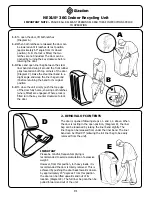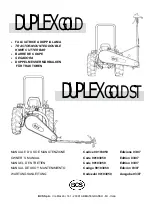
INSTRUCTIONS FOR USE
AGT 850 / 860
55
CONTROL OF HYDRAULICS THROUGH QUICK COUPLING (SINGLE)
Control lever B
Control lever redirects oil from pressure circuit through one-way functioning directional control valve
through hydraulic output or quick coupling, for control of external hydraulic connections with one-way
functioning hydraulic cylinder (e.g. implements with hydraulic system for tilting, such as dump trailers
etc.).
This applies to standard tractor version, without installed front hydraulic lift mechanism. If the front
hydraulic lift mechanism (option) is installed, control lever, in addition to redirecting oil through
hydraulic output or quick coupling, also control the front hydraulic lift mechanism. This means that the
control lever, in this hydraulic connection, individually controls function in the front or rear, depending
on the connection on the quick coupling, for current work requirement of the user.
Operation:
If you move the lever up to position 1, one-way
functioning hydraulic cylinder on the implement
is supplied with oil under pressure, and the
hydraulic cylinder starts to rise. When you release
it, the lever on the control element automatically
returns to neutral position 0. Hydraulic cylinder
remains on lift position.
If you move the lever down to position 2, you
release oil flow from one-way hydraulic cylinder
back to hydraulic system of the tractor. Cylinder
on the implement, with the help of external force
or built-in spring (depending on version), starts to
lower.
Control lever B, the same as control lever A, after
release, remains fixed in position 2. Therefore,
you must always shift it to position 0, if you wish
to cancel lowering of hydraulic cylinder on the implement.
CONTROL OF HYDRAULICS THROUGH QUICK COUPLING (DOUBLE)
Control lever C
Control lever redirects oil from pressure circuit through two-way functioning directional control valve
through hydraulic output or quick coupling, for control of external hydraulic connections with two-way
functioning hydraulic cylinder.
Operation:
When you move the control lever for
operation of control valve into one of the
positions (1 or 2), the piston in the valve
moves in a way that oil from the pressure
line flows only through one connection and
from return through other connection and
vice versa, if you shift the control lever in
other direction.
When you release it, the lever on the control
element automatically returns back to
neutral, regardless of previous position.
2
1
0








































